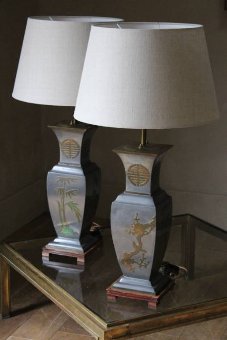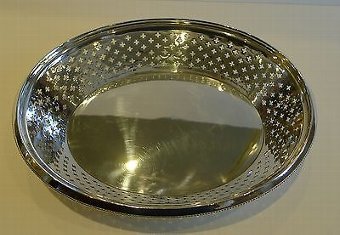featured item

quality pair of antique edwardian postal scales and weights Read more
19th century chinese cloisonne lidded jar

antiques available from other sellers in antiques interior design modern and vintage > other interior design
-
![A pair of brass inlaid pewter lamps]() £1150.00
£1150.00a pair of brass inlaid pewter lamps Read more
Seveteen-Twentyone -
![3 George IV Mahogany and Gilded Pelmets]() £1750.00
£1750.003 george iv mahogany and gilded pelmets Read more
Georgian Antiques -
![Annabella, Lady Brinckman (1803-1864), Daughter of John Corbet of Sundorne]() £700.00
£700.00annabella, lady brinckman (1803-1864), daughter of john c... Read more
Artware Ltd -
![Smart Antique English Silver Plate Bread Basket by Atkin Brothers c.1875]() £190.61
£190.61smart antique english silver plate bread basket by atkin ... Read more
Puckering's
- View other items in:
- antiques interior design modern and vintage
- other interior design
Still not found something similar? Why not save a search and get a notification in your inbox when an matching antique is added to our ever-growing database?
Enter your email address to be sent alerts when new items are added to the site that match your search criteria

Ref 11458 - 19th century Chinese Cloisonne lidded jar, decorated with humourous dragons, circa 1890. Diameter 3.75 inches, 10 cms.
From Byzantium or the Islamic world the technique reached China in the 13-14th centuries; the first written reference is in a book of 1388, where it is called "Dashi (''Muslim'') ware". No Chinese pieces clearly from the 14th century are known, the earliest datable pieces being from the reign of the Xuande Emperor (1425–35), which however show a full use of Chinese styles suggesting considerable experience in the technique. It was initially regarded with suspicion by Chinese connoisseurs, firstly as being foreign, and secondly as appealing to feminine taste. However by the beginning of the 18th century the Kangxi Emperor had a cloisonné workshop among the many Imperial factories. The most elaborate and highly-valued Chinese pieces are from the early Ming Dynasty, especially the reigns of the Xuande Emperor and Jingtai Emperor (1450–57), although 19th century or modern pieces are far more common. The Chinese industry seems to have benefited from a number of skilled Byzantine refugees fleeing the Fall of Constantinople in 1453. In Chinese cloisonné blue is usually the predominant colour, and the Chinese name for the technique, jingtailan ("Jingtai blue ware"), refers to this, and the Jingtai Emperor. Quality began to decline in the 19th century. Initially heavy bronze or brass bodies were used, and the wires soldered, but later much lighter copper vessels were used, and the wire glued on before firing.
In Byzantine pieces, and even more in Chinese work, the wire by no means always encloses a separate color of enamel. Sometime a wire is used just for decorative effect, stopping in the middle of a field of enamel, and sometimes the boundary between two enamel colors is not marked by a wire. Chinese cloisonné is the best known enamel cloisonné, though the Japanese produced large quantities from the mid-19th century, of very high technical quality. Russian cloisonné from the Tsarist era is also highly prized by collectors, especially from the House of Fabergé or Khlebnikov, and the French and other nations have produced small quantities. Chinese cloisonné is sometimes confused with Canton enamel, a similar type of enamel work that is painted on freehand and does not utilize partitions to hold the colors separate. In medieval Western Europe cloisonné enamel technique was gradually overtaken by the rise of champlevé enamel, where the spaces for the enamel to fill are created by making recesses (using various methods) into the base object, rather than building up compartments from it, as in cloisonné. Later techniques were evolved that allowed the enamel to be painted onto a flat background without running. Plique-à-jour is a related enameling technique which uses clear enamels and no metal backplate, producing an object that has the appearance of a miniature stained glass object - in effect cloisonné with no backing. Other ways of using the technique have been developed, but are of minor importance. In 19th century Japan it was used on pottery vessels with ceramic glazes, and it has been used with lacquer
and modern acrylic fillings for the cloisons.
cloison. The piece is left to dry completely before firing, which is done by putting the article, with its enamel fillings, in a kiln. The enamel in the cloisons will sink down a lot after firing. This process is repeated until all cloisons are filled. Three styles of cloisonné are most often seen: concave, convex, and flat. The finishing method determines this final appearance. With concave cloisonné the cloisons are not completely filled. Capillary action causes the enamel surface to curve up against the cloisonné wire when the enamel is molten, producing a concave appearance. Convex cloissoné is produced by overfilling each cloison, at the last firing. This gives each color area the appearance of slightly rounded mounds. Flat cloisonné is the most common. After all the cloisons are filled the enamel is ground down to a smooth surface with lapidary equipment, using the same techniques as are used for polishing cabochon stones. The top of the cloisonné wire is polished so it is flush with the enamel and has a bright lustre. Some cloisonné enamel is electroplated with a thin film of gold, which will not tarnish as silver does. (Wikepedia)
Antiques.co.uk Ref: J5UNTAFP
- Width (cm):
- 0
- Height (cm):
- 0
- Depth (cm):
- 0
Here on antiques co uk we love antiques and specialise in selling antiques. Even though this item was for sale and is now sold or otherwise now unavailable we have many more items for sale including vintage antiques, silver, tables, watches, jewellery and much more for your interiors and home.
Search all the antiques currently for sale on www.antiques co uk. Or why not consider selling your antiques and making sales more easily with us!









